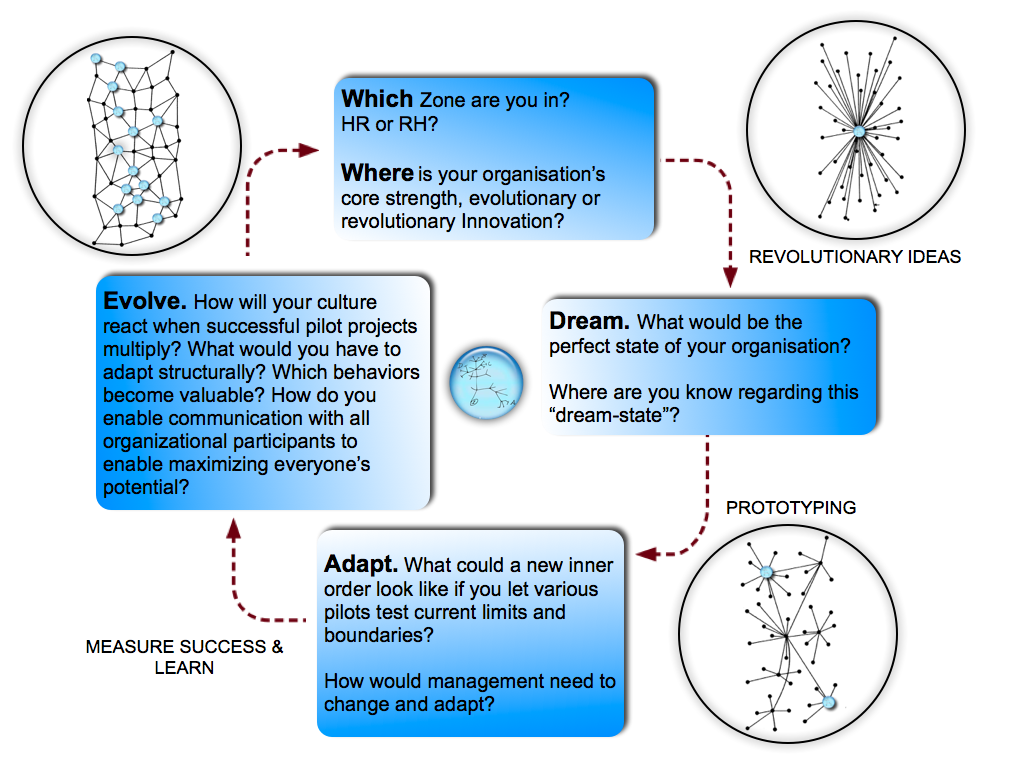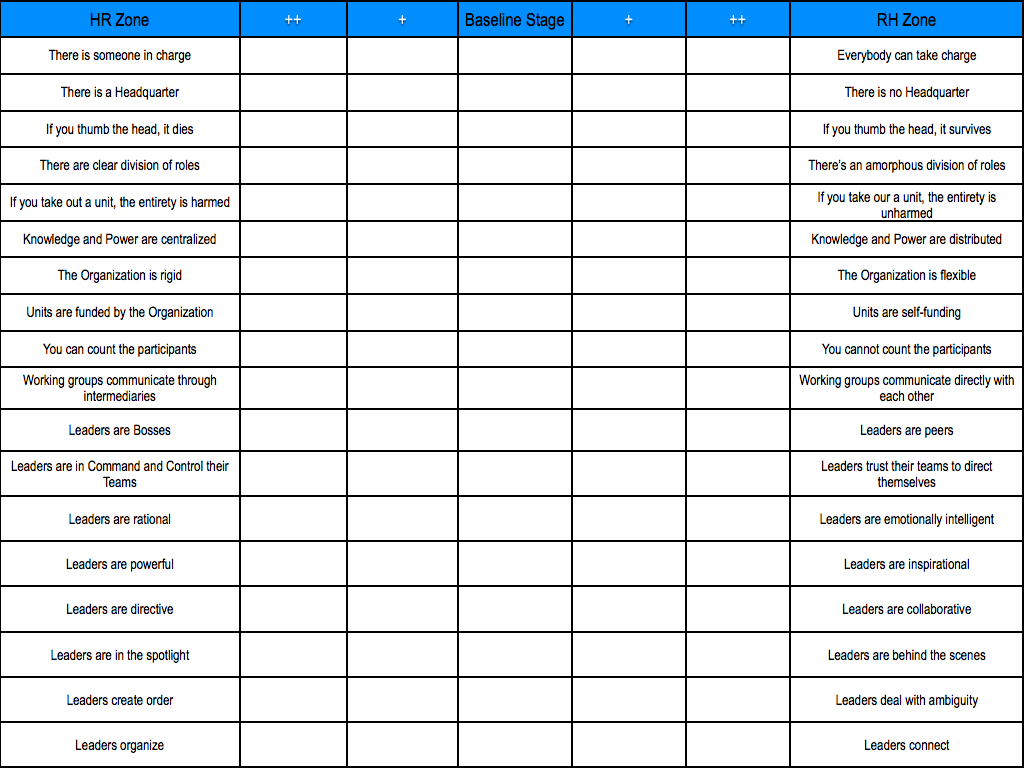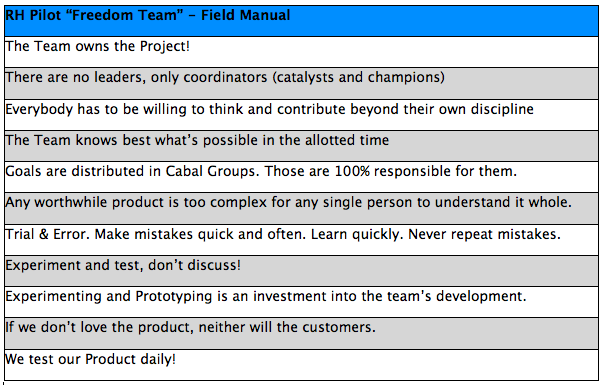Kill HR! From Human Resources to Resourceful Humans
Hacking Team
Adding value comes by looking outside the company as much as inside. The RH-Way is all about understanding that the network of talent, which is your organisation, in itself is a social medium. This group constitutes the organisation, these people create structures, lead and innovate. There is no such thing as 'the organisation' - Talent and therefore Resourceful Humans are everything. By removing all barrierers and folding the customer community into your internal community, Resourceful Humans create a talent-centric setup. Either you create or you sell, nothing should stand between people and their customers.
Creating this environment is the Job of the RH enabling Change Force!
The RH-Way reboots an Organization's entrepreneurial spirit. In the words of HP Founder Dave Packard, 'The Purpose of a Company is NOT to make money! It makes money in order to do what it is really all about, and in our case that's to make a meaningful contribution to the people who work here and the communities we operate in.'
Resourceful Humans pre-empts the issues of size, hierarchies, apathy and ignorance by creating a a peer-creation culture. It enable the mindset and tools for a healthy self-sustaining culture of Innovation. Regardless of hierarchy, everyone will have the same opportunity to approach work in the most innovative, productive and efficient manner, based on networks of self-organized contracts with shared goals. Purposeful accomplices who can design their own work environment to create the best possible product of service, will not employ normal management tools and techniques.
What does an environment of Resourceful Humans look like?
No Hierarchies but Circles
Each teams resembles a circle: independent and autonomous. Once you join, you’re an equal. Its then up to you to contribute to the best of your ability in service of the shared idea.
No Mission Statement but Ideology
Ideology is the glue that holds distributed organizations together. It consists of authentic, often unarticulated, belief in the purpose of the team and organization's benefit to the community. Not Central Strategy, but fluid, mutating Network. Resourceful Humans do not perceived organizations as confining constructs, but as enabling platforms - semi-permeable membranes. The Resourceful Humans Concept lets them associate freely to the enterprise in whatever form they chose, as long as they are accepted by the receiving team.
No Leaders but Catalysts
Leaders of Resourceful Humans-centric organizations are vastly different from traditional executives. A catalyst is any element that initiates a reaction without fusing into that reaction. In open organizations, a catalyst is the person who initiates a circle and then fades away into the background. They generated ideas and then allow the circle to follow through. They get a decentralized organization going and then cede control to the members. Letting go of the leadership role, the catalyst transfers ownership and responsibility to the circle. The catalyst is an inspirational figure who spurs others to action. Circles don’t form on their own. A catalyst develops an idea, shares it with others, and leads by example.
No Project Managers, but Champions
A champion is relentless implementer, promoting a new idea. Catalysts are charismatic, but champions take it to the next level. Catalysts inspire and naturally connect people, but there’s nothing subtle about the champion. He is a natural people person, salesman and builder. He translates vision into reality.
A practical exampe?
People in a company living the RH-Way asked to design a radical new bonus system, as none of the traditional models seemed to be fair to them. They created an online platform, where each employee could log onto. Depending on their seniority, each employee had a number of stars at his disposal to reward fellow employees with online on a quarterly basis. They could award stars to whomever and add commentaries as to why they awarded them. The Revenue and Profit statements of the company were available online, and at the end of the year, based on the EBIT, each star transparently received a monetary value. The employees created their own social feedback and bonus distribution platform. No more arguing with managers about unfair apraisals. No more bell-curves. No more intransparent and complex bonus calculations and administration by HR. Resourceful Humans became the solution.



Yes, I agree! Good post and references. Thanks.
I like it - what more can I say! A real manifesto for change - a fundamental change in thinking, a pre-requisite for change to occur.
Hi Heiko - I can't believe no-one is on the team for this hack yet - unless they think this is already a completed one!!
In my view HR and people practitioners should start to become the change it and they want the organisation to be, and I reckon the key area would be around the systems thinking as espoused and demonstrated both academically and eminently practically by Deming, John Seddon in Vanguard, Senge, Ackoff, Scholtes, and countless others.
All change beings at the thinking level and not the doing level, yet the result of the change in thinking then delivers change at the doing level. Great intentions, motivation and competencies underpinned by the wrong thinking changes little.
Managers need to recognise the organisation as a system, it’s their job to remove the obstacles within the organisation. They also need to understand human motivation (Dan Pink, Alfie Kohn, etc.). Design of the work from the outside in, and focus on what is the real purpose what matters to the customer. Then, analyse the demand, design measures for what matters, then when you understand the systems thinking that determines the current way of doing things, you simply get the people who do the work to re-design the work in order to achieve purpose and what really matters, and what happens is almost magical! Service improves, costs reduce, morale increases, and the culture change happens for free. At no time do we do anything to the people, we simply get the people to work on the work. That's the systems thinking at the practical and yet quite profound level that I believe HR could help to make organisations more adaptable and adept.
If you want to work more on the Systems Thinking hack, please join the team on page 2!



You need to register in order to submit a comment.